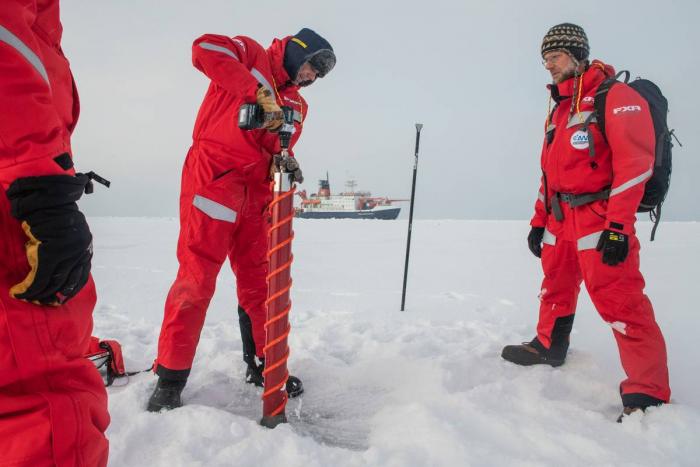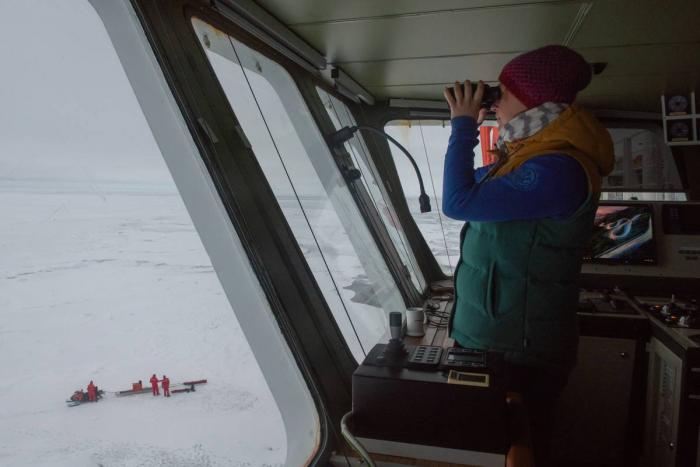On the Ice!
Fedorov set up our first site on the ice yesterday! The day opened with a beautiful sunrise and just got better from there. People were very excited to finally be able to get their research equipment out onto an ice floe and begin collecting data. Today, site L1 of the distributed network is in place. This is a big deal for everyone on board. Read more about the selection site in the New York Times.

Everything for MOSAiC revolves around the main ice camp on the floe Polarstern is freezing in to. This means that no major steps could take place until they found their ice. As soon as that was determined, ice analysts pored over satellite images. They were trying to pick out other areas of sea ice that would work for the distributed network.
The idea with the distributed network is to gather information on ice, air, and ocean conditions and processes throughout the year surrounding the main research site. They are deploying a variety of buoy sensors and meteorological (weather) stations 5-20 miles from Polarstern's main ice camp. This will help put the data from the ice camp into a broader context. It will also allow researchers to check how representative that area is or if there is a lot of variability across a few miles. And the datasets from the distributed network will be valuable on their own. Some research can only take place away from Polarstern because of the specifics of the sea ice conditions they want to study or the need to be farther away from the heat and emissions from Polarstern itself.
Overall, they are looking for 3 floes for L-Sites and 8 floes for M-Sites. More equipment is deployed at the L-Sites; therefore, these floes have to be fairly big and thick -- though not the ice fortress of the main site. First, some options were identified using satellite images. These choices were then checked by a helicopter team and ice coring. So far, one good L-Site location and two good M-Site locations have been found. There are a few decent options for the 2 remaining L-Sites and the search continues for M-sites.
This is important work that is happening behind the scenes. But for most of us, the excitement came when we were finally able to get out on the ice! Early in the morning yesterday, 3 people went to check ice conditions and do a scan for polar bears around the L1 site. Four more of us were on Polar Bear Watch in the bridge, scanning the icy landscape with binoculars for anything moving or a different shade of white than the snow and ice. It was a great place to be at that time; I got insight into how decisions are made regarding where equipment and pathways will be placed on the ice, and I got to watch the sunrise while looking for brears.

After the survey crew gave the thumbs up on ice thickness, more than 30 researchers, graduate students, and logistics support people headed out onto the ice floe. The crane unloaded gear onto the floe. Meanwhile, people suited up in cold-weather gear and stepped off the gangway (removable stairs or ramp that is used to get from the ship to the dock -- or in this case, the ice). Two snowmachines revved up and began moving ice drills and buoys and gear to specific spots on the ice.
The list of sensors and buoys that were deployed is staggering. When I return to regular internet access, I'll share some diagrams and photos of them. It is actually really interesting -- but good visuals are important!
I was fortunate to be included in the group work on the ice. I assisted with the set up of the meteorological station, installing many sensors: wind, temperature, snow depth, humidity (water vapor in the air), and much more. The number of cables and wires required is remarkable! I also helped to deploy a buoy that will collect information on ocean currents, water temperature, water salinity (amount of salt), and much more.
Spending time out on the sea ice was incredible. It was cold, especially when we had to remove our gloves to work with small fittings and wires. My nostrils froze together a little bit from time to time. Frost accumulated on everything -- including my hair! But the cold was well worth it. The landscape was astoundingly beautiful and the coordinated work to get the science equipment deployed was also beautiful to observe. From a brilliant orange sunrise at 8 am through to a long, diffused pink sunset at 3 pm and capped off by icy snow drifts sparkling in the lights of the ship, it was breathtaking. I even took a moment to make a snow angel as we finished up our work. It was truly a great day!
Your Questions and Curiosities
What is the different between ripple ice and pressure ridges? I actually am not quite sure what the term ripple ice refers to. I asked the ice experts on board and they weren't familiar with it. So let's start with what I do know. Pressure ridges form when two ice floes collide. The floes are pushed together by wind and/or water currents. The ice has to be more than about 10 centimenters thick to create pressure ridges. Pieces break, fold, and compress on top of each other, creating these ridges. They are basically piles of ice. These piles can also build up at the bottom of the ice, so the topography is often a mirror image underwater. Because more of the ice sits underwater to begin with, these underwater pressure ridges are usually 2-4 times deeper than the ridge that forms on top!
Ripple ice might refer to rippled patterns that form in thinner ice. This can happen as grease ice freezes into nilas or young grey ice in watery leads. Slight differences in timing of freezing creates differences in the thickness, temperature, or air bubbles in the ice. Some of these differences can be easily seen as ripples running parallel to the lead. Some aren't visible themselves, but may attract more frost or hold on to small snow drifts. Otherwise, ripple ice may also refer to slight compressions that could happen as nilas or young grey ice in leads is pushed together or pulled apart when the surrounding ice diverges(moves apart) or converges(moves together). But those are just guesses!
Education Extension
Students can learn a lot of science content, science practices, and teamwork through planning a mock Arctic expedition. As a simple exercise after learning about MOSAiC or Arctic research in their region, have them think about all of the factors that affect how, when, and where equipment is deployed. And how do you adapt plans when the weather changes? Or equipment doesn't work? Or ice conditions aren't what was expected? One of the graduate students on the Fedorov is even thinking of creating a board game about this topic.
The unit Do your really want to visit the Arctic in the Arctic ClimateThe average weather over a particular region of the Earth. Climate originates in recurring weather phenomenon that result from specific types of atmospheric circulation. Curriculum uses Arctic weather data for students to role-play the planning of an expedition to the Arctic.
Chart the Polarstern's location over time using this updated location information. There are high winds predicted for tomorrow, so the ice floe it is linked to will probably drift a significant amount over the next few days.


Comments